Cultural Safety in Healthcare
VerifiedAdded on 2023/06/08
|10
|2192
|174
AI Summary
This article discusses cultural safety in healthcare and how to achieve it. It explores the importance of cultural values, beliefs, and behaviors in providing quality healthcare in a multicultural environment. The author reflects on their own values, beliefs, and behaviors and how they contribute to or detract from culturally safe healthcare practices.
Contribute Materials
Your contribution can guide someone’s learning journey. Share your
documents today.
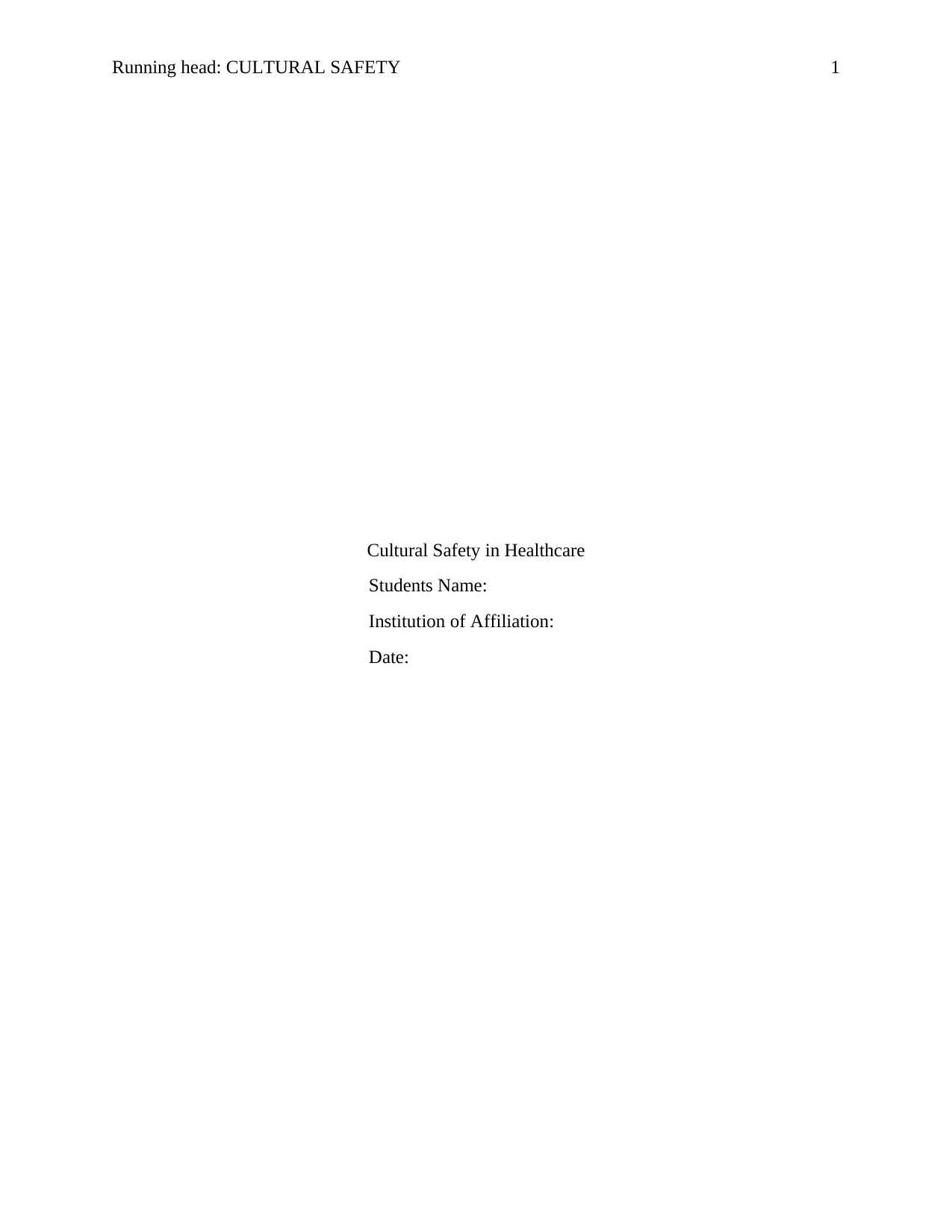
Running head: CULTURAL SAFETY 1
Cultural Safety in Healthcare
Students Name:
Institution of Affiliation:
Date:
Cultural Safety in Healthcare
Students Name:
Institution of Affiliation:
Date:
Secure Best Marks with AI Grader
Need help grading? Try our AI Grader for instant feedback on your assignments.
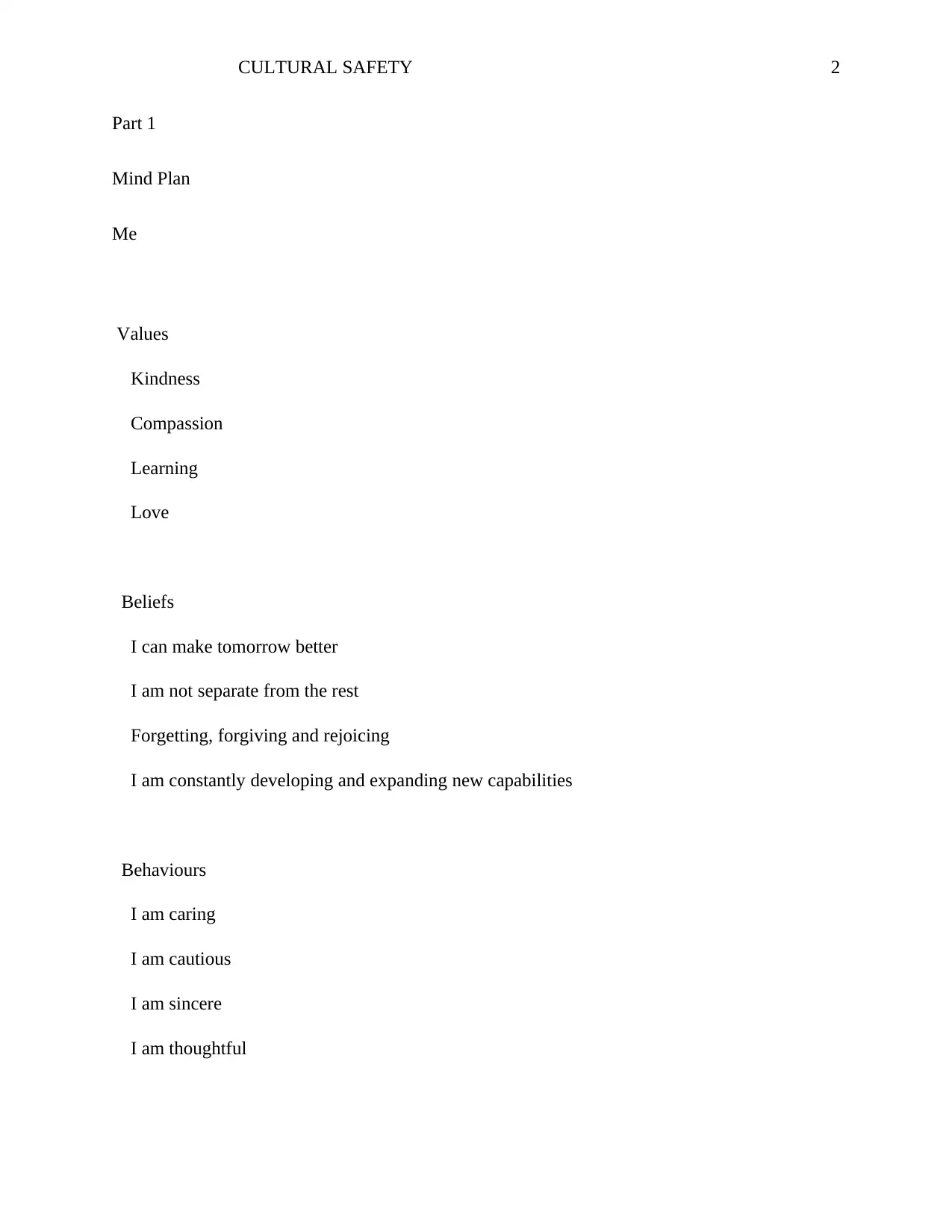
CULTURAL SAFETY 2
Part 1
Mind Plan
Me
Values
Kindness
Compassion
Learning
Love
Beliefs
I can make tomorrow better
I am not separate from the rest
Forgetting, forgiving and rejoicing
I am constantly developing and expanding new capabilities
Behaviours
I am caring
I am cautious
I am sincere
I am thoughtful
Part 1
Mind Plan
Me
Values
Kindness
Compassion
Learning
Love
Beliefs
I can make tomorrow better
I am not separate from the rest
Forgetting, forgiving and rejoicing
I am constantly developing and expanding new capabilities
Behaviours
I am caring
I am cautious
I am sincere
I am thoughtful
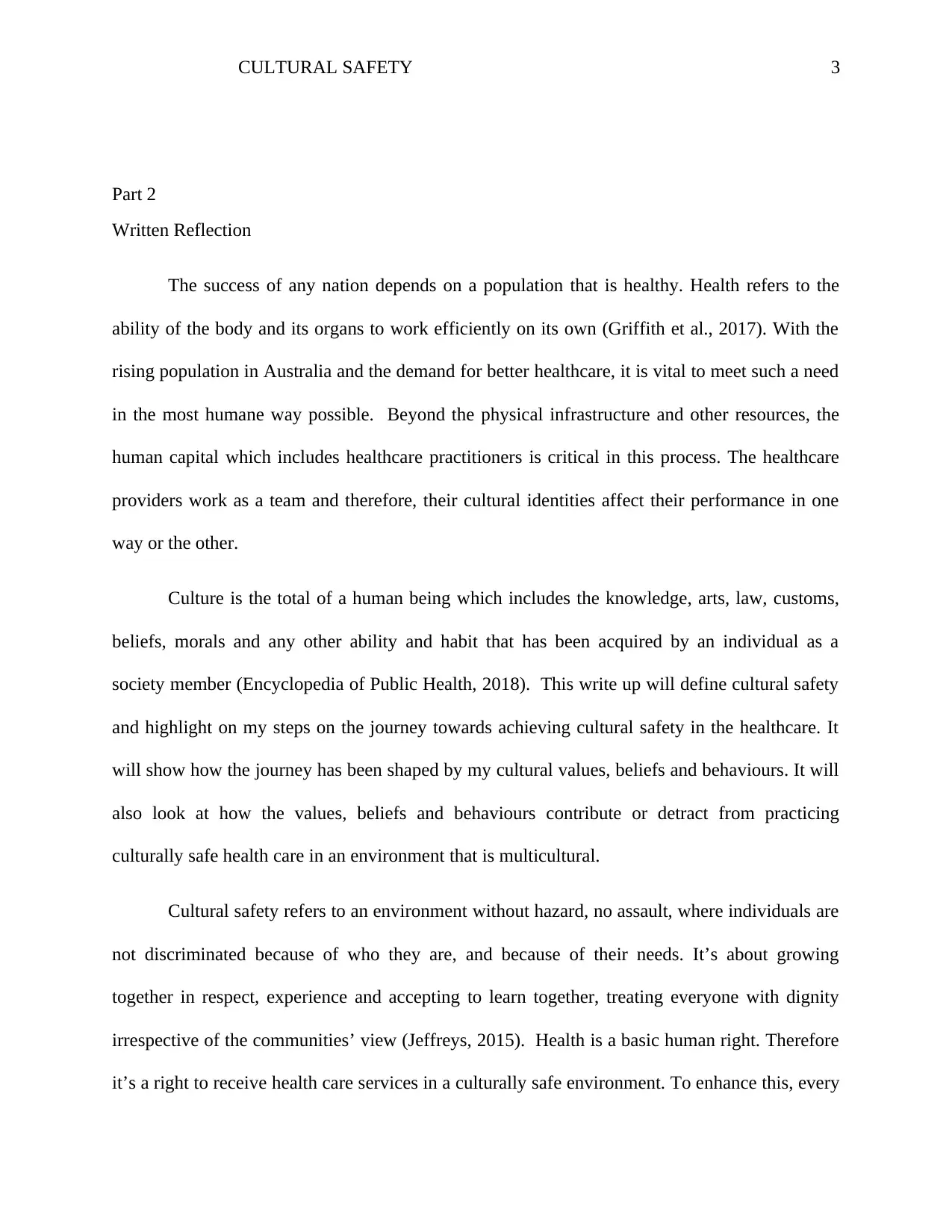
CULTURAL SAFETY 3
Part 2
Written Reflection
The success of any nation depends on a population that is healthy. Health refers to the
ability of the body and its organs to work efficiently on its own (Griffith et al., 2017). With the
rising population in Australia and the demand for better healthcare, it is vital to meet such a need
in the most humane way possible. Beyond the physical infrastructure and other resources, the
human capital which includes healthcare practitioners is critical in this process. The healthcare
providers work as a team and therefore, their cultural identities affect their performance in one
way or the other.
Culture is the total of a human being which includes the knowledge, arts, law, customs,
beliefs, morals and any other ability and habit that has been acquired by an individual as a
society member (Encyclopedia of Public Health, 2018). This write up will define cultural safety
and highlight on my steps on the journey towards achieving cultural safety in the healthcare. It
will show how the journey has been shaped by my cultural values, beliefs and behaviours. It will
also look at how the values, beliefs and behaviours contribute or detract from practicing
culturally safe health care in an environment that is multicultural.
Cultural safety refers to an environment without hazard, no assault, where individuals are
not discriminated because of who they are, and because of their needs. It’s about growing
together in respect, experience and accepting to learn together, treating everyone with dignity
irrespective of the communities’ view (Jeffreys, 2015). Health is a basic human right. Therefore
it’s a right to receive health care services in a culturally safe environment. To enhance this, every
Part 2
Written Reflection
The success of any nation depends on a population that is healthy. Health refers to the
ability of the body and its organs to work efficiently on its own (Griffith et al., 2017). With the
rising population in Australia and the demand for better healthcare, it is vital to meet such a need
in the most humane way possible. Beyond the physical infrastructure and other resources, the
human capital which includes healthcare practitioners is critical in this process. The healthcare
providers work as a team and therefore, their cultural identities affect their performance in one
way or the other.
Culture is the total of a human being which includes the knowledge, arts, law, customs,
beliefs, morals and any other ability and habit that has been acquired by an individual as a
society member (Encyclopedia of Public Health, 2018). This write up will define cultural safety
and highlight on my steps on the journey towards achieving cultural safety in the healthcare. It
will show how the journey has been shaped by my cultural values, beliefs and behaviours. It will
also look at how the values, beliefs and behaviours contribute or detract from practicing
culturally safe health care in an environment that is multicultural.
Cultural safety refers to an environment without hazard, no assault, where individuals are
not discriminated because of who they are, and because of their needs. It’s about growing
together in respect, experience and accepting to learn together, treating everyone with dignity
irrespective of the communities’ view (Jeffreys, 2015). Health is a basic human right. Therefore
it’s a right to receive health care services in a culturally safe environment. To enhance this, every
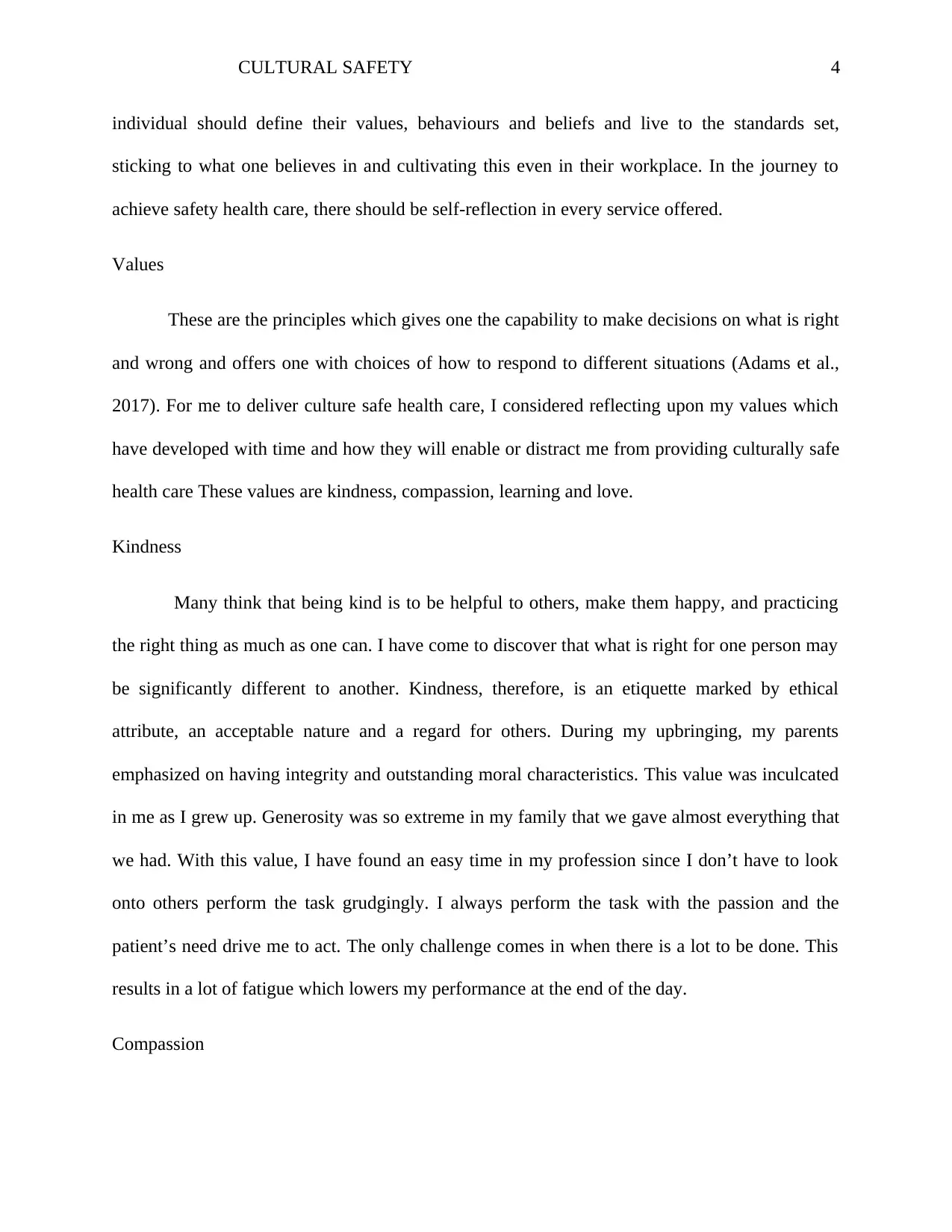
CULTURAL SAFETY 4
individual should define their values, behaviours and beliefs and live to the standards set,
sticking to what one believes in and cultivating this even in their workplace. In the journey to
achieve safety health care, there should be self-reflection in every service offered.
Values
These are the principles which gives one the capability to make decisions on what is right
and wrong and offers one with choices of how to respond to different situations (Adams et al.,
2017). For me to deliver culture safe health care, I considered reflecting upon my values which
have developed with time and how they will enable or distract me from providing culturally safe
health care These values are kindness, compassion, learning and love.
Kindness
Many think that being kind is to be helpful to others, make them happy, and practicing
the right thing as much as one can. I have come to discover that what is right for one person may
be significantly different to another. Kindness, therefore, is an etiquette marked by ethical
attribute, an acceptable nature and a regard for others. During my upbringing, my parents
emphasized on having integrity and outstanding moral characteristics. This value was inculcated
in me as I grew up. Generosity was so extreme in my family that we gave almost everything that
we had. With this value, I have found an easy time in my profession since I don’t have to look
onto others perform the task grudgingly. I always perform the task with the passion and the
patient’s need drive me to act. The only challenge comes in when there is a lot to be done. This
results in a lot of fatigue which lowers my performance at the end of the day.
Compassion
individual should define their values, behaviours and beliefs and live to the standards set,
sticking to what one believes in and cultivating this even in their workplace. In the journey to
achieve safety health care, there should be self-reflection in every service offered.
Values
These are the principles which gives one the capability to make decisions on what is right
and wrong and offers one with choices of how to respond to different situations (Adams et al.,
2017). For me to deliver culture safe health care, I considered reflecting upon my values which
have developed with time and how they will enable or distract me from providing culturally safe
health care These values are kindness, compassion, learning and love.
Kindness
Many think that being kind is to be helpful to others, make them happy, and practicing
the right thing as much as one can. I have come to discover that what is right for one person may
be significantly different to another. Kindness, therefore, is an etiquette marked by ethical
attribute, an acceptable nature and a regard for others. During my upbringing, my parents
emphasized on having integrity and outstanding moral characteristics. This value was inculcated
in me as I grew up. Generosity was so extreme in my family that we gave almost everything that
we had. With this value, I have found an easy time in my profession since I don’t have to look
onto others perform the task grudgingly. I always perform the task with the passion and the
patient’s need drive me to act. The only challenge comes in when there is a lot to be done. This
results in a lot of fatigue which lowers my performance at the end of the day.
Compassion
Secure Best Marks with AI Grader
Need help grading? Try our AI Grader for instant feedback on your assignments.
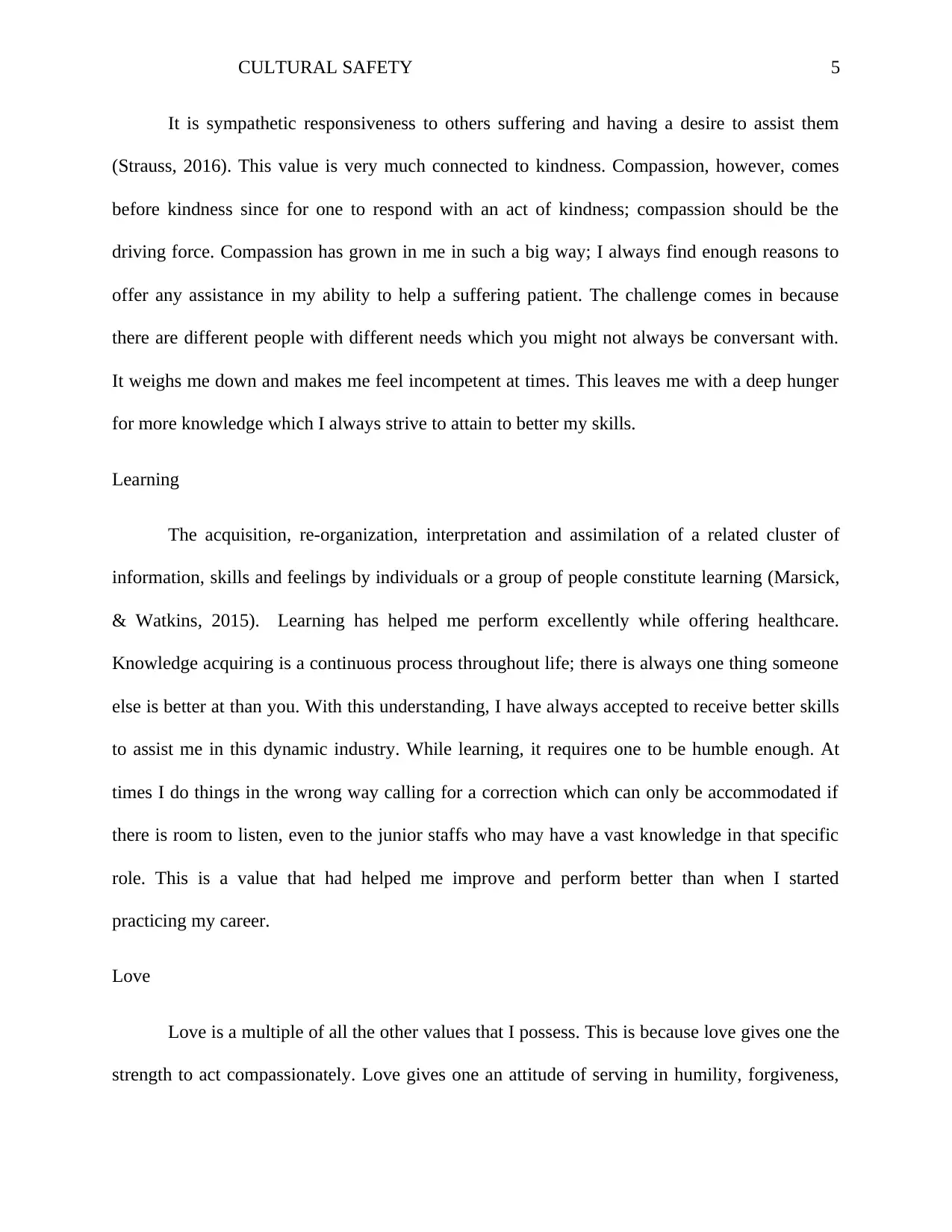
CULTURAL SAFETY 5
It is sympathetic responsiveness to others suffering and having a desire to assist them
(Strauss, 2016). This value is very much connected to kindness. Compassion, however, comes
before kindness since for one to respond with an act of kindness; compassion should be the
driving force. Compassion has grown in me in such a big way; I always find enough reasons to
offer any assistance in my ability to help a suffering patient. The challenge comes in because
there are different people with different needs which you might not always be conversant with.
It weighs me down and makes me feel incompetent at times. This leaves me with a deep hunger
for more knowledge which I always strive to attain to better my skills.
Learning
The acquisition, re-organization, interpretation and assimilation of a related cluster of
information, skills and feelings by individuals or a group of people constitute learning (Marsick,
& Watkins, 2015). Learning has helped me perform excellently while offering healthcare.
Knowledge acquiring is a continuous process throughout life; there is always one thing someone
else is better at than you. With this understanding, I have always accepted to receive better skills
to assist me in this dynamic industry. While learning, it requires one to be humble enough. At
times I do things in the wrong way calling for a correction which can only be accommodated if
there is room to listen, even to the junior staffs who may have a vast knowledge in that specific
role. This is a value that had helped me improve and perform better than when I started
practicing my career.
Love
Love is a multiple of all the other values that I possess. This is because love gives one the
strength to act compassionately. Love gives one an attitude of serving in humility, forgiveness,
It is sympathetic responsiveness to others suffering and having a desire to assist them
(Strauss, 2016). This value is very much connected to kindness. Compassion, however, comes
before kindness since for one to respond with an act of kindness; compassion should be the
driving force. Compassion has grown in me in such a big way; I always find enough reasons to
offer any assistance in my ability to help a suffering patient. The challenge comes in because
there are different people with different needs which you might not always be conversant with.
It weighs me down and makes me feel incompetent at times. This leaves me with a deep hunger
for more knowledge which I always strive to attain to better my skills.
Learning
The acquisition, re-organization, interpretation and assimilation of a related cluster of
information, skills and feelings by individuals or a group of people constitute learning (Marsick,
& Watkins, 2015). Learning has helped me perform excellently while offering healthcare.
Knowledge acquiring is a continuous process throughout life; there is always one thing someone
else is better at than you. With this understanding, I have always accepted to receive better skills
to assist me in this dynamic industry. While learning, it requires one to be humble enough. At
times I do things in the wrong way calling for a correction which can only be accommodated if
there is room to listen, even to the junior staffs who may have a vast knowledge in that specific
role. This is a value that had helped me improve and perform better than when I started
practicing my career.
Love
Love is a multiple of all the other values that I possess. This is because love gives one the
strength to act compassionately. Love gives one an attitude of serving in humility, forgiveness,
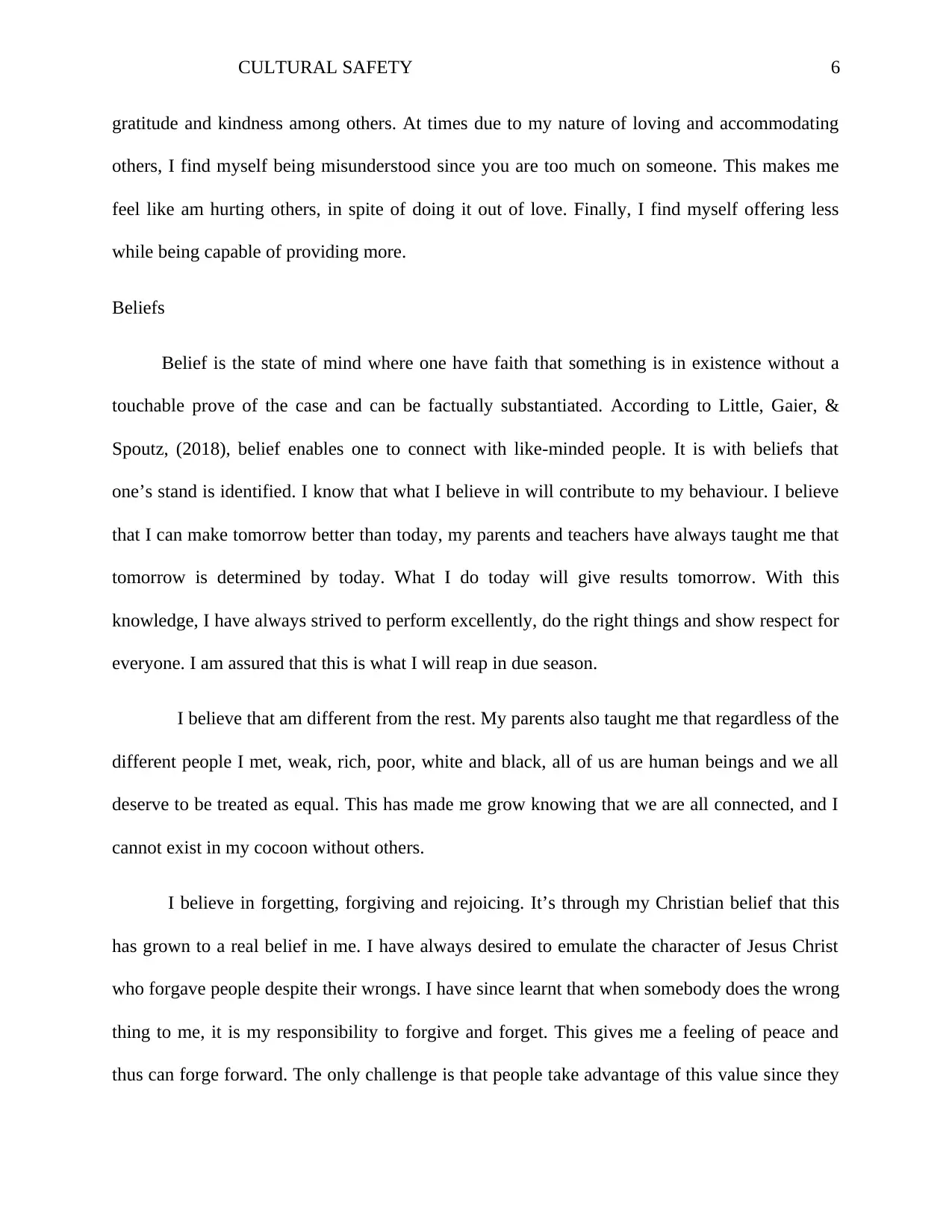
CULTURAL SAFETY 6
gratitude and kindness among others. At times due to my nature of loving and accommodating
others, I find myself being misunderstood since you are too much on someone. This makes me
feel like am hurting others, in spite of doing it out of love. Finally, I find myself offering less
while being capable of providing more.
Beliefs
Belief is the state of mind where one have faith that something is in existence without a
touchable prove of the case and can be factually substantiated. According to Little, Gaier, &
Spoutz, (2018), belief enables one to connect with like-minded people. It is with beliefs that
one’s stand is identified. I know that what I believe in will contribute to my behaviour. I believe
that I can make tomorrow better than today, my parents and teachers have always taught me that
tomorrow is determined by today. What I do today will give results tomorrow. With this
knowledge, I have always strived to perform excellently, do the right things and show respect for
everyone. I am assured that this is what I will reap in due season.
I believe that am different from the rest. My parents also taught me that regardless of the
different people I met, weak, rich, poor, white and black, all of us are human beings and we all
deserve to be treated as equal. This has made me grow knowing that we are all connected, and I
cannot exist in my cocoon without others.
I believe in forgetting, forgiving and rejoicing. It’s through my Christian belief that this
has grown to a real belief in me. I have always desired to emulate the character of Jesus Christ
who forgave people despite their wrongs. I have since learnt that when somebody does the wrong
thing to me, it is my responsibility to forgive and forget. This gives me a feeling of peace and
thus can forge forward. The only challenge is that people take advantage of this value since they
gratitude and kindness among others. At times due to my nature of loving and accommodating
others, I find myself being misunderstood since you are too much on someone. This makes me
feel like am hurting others, in spite of doing it out of love. Finally, I find myself offering less
while being capable of providing more.
Beliefs
Belief is the state of mind where one have faith that something is in existence without a
touchable prove of the case and can be factually substantiated. According to Little, Gaier, &
Spoutz, (2018), belief enables one to connect with like-minded people. It is with beliefs that
one’s stand is identified. I know that what I believe in will contribute to my behaviour. I believe
that I can make tomorrow better than today, my parents and teachers have always taught me that
tomorrow is determined by today. What I do today will give results tomorrow. With this
knowledge, I have always strived to perform excellently, do the right things and show respect for
everyone. I am assured that this is what I will reap in due season.
I believe that am different from the rest. My parents also taught me that regardless of the
different people I met, weak, rich, poor, white and black, all of us are human beings and we all
deserve to be treated as equal. This has made me grow knowing that we are all connected, and I
cannot exist in my cocoon without others.
I believe in forgetting, forgiving and rejoicing. It’s through my Christian belief that this
has grown to a real belief in me. I have always desired to emulate the character of Jesus Christ
who forgave people despite their wrongs. I have since learnt that when somebody does the wrong
thing to me, it is my responsibility to forgive and forget. This gives me a feeling of peace and
thus can forge forward. The only challenge is that people take advantage of this value since they
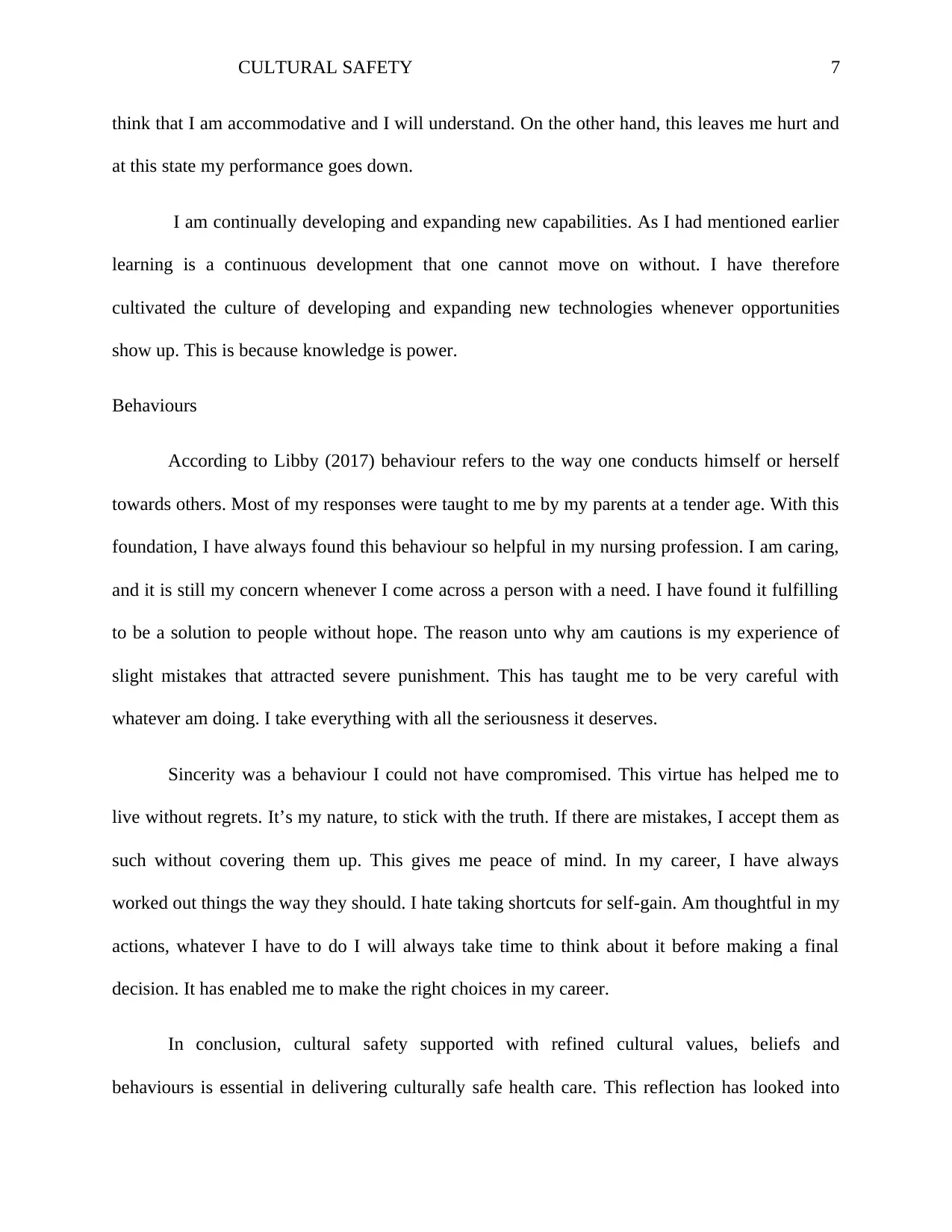
CULTURAL SAFETY 7
think that I am accommodative and I will understand. On the other hand, this leaves me hurt and
at this state my performance goes down.
I am continually developing and expanding new capabilities. As I had mentioned earlier
learning is a continuous development that one cannot move on without. I have therefore
cultivated the culture of developing and expanding new technologies whenever opportunities
show up. This is because knowledge is power.
Behaviours
According to Libby (2017) behaviour refers to the way one conducts himself or herself
towards others. Most of my responses were taught to me by my parents at a tender age. With this
foundation, I have always found this behaviour so helpful in my nursing profession. I am caring,
and it is still my concern whenever I come across a person with a need. I have found it fulfilling
to be a solution to people without hope. The reason unto why am cautions is my experience of
slight mistakes that attracted severe punishment. This has taught me to be very careful with
whatever am doing. I take everything with all the seriousness it deserves.
Sincerity was a behaviour I could not have compromised. This virtue has helped me to
live without regrets. It’s my nature, to stick with the truth. If there are mistakes, I accept them as
such without covering them up. This gives me peace of mind. In my career, I have always
worked out things the way they should. I hate taking shortcuts for self-gain. Am thoughtful in my
actions, whatever I have to do I will always take time to think about it before making a final
decision. It has enabled me to make the right choices in my career.
In conclusion, cultural safety supported with refined cultural values, beliefs and
behaviours is essential in delivering culturally safe health care. This reflection has looked into
think that I am accommodative and I will understand. On the other hand, this leaves me hurt and
at this state my performance goes down.
I am continually developing and expanding new capabilities. As I had mentioned earlier
learning is a continuous development that one cannot move on without. I have therefore
cultivated the culture of developing and expanding new technologies whenever opportunities
show up. This is because knowledge is power.
Behaviours
According to Libby (2017) behaviour refers to the way one conducts himself or herself
towards others. Most of my responses were taught to me by my parents at a tender age. With this
foundation, I have always found this behaviour so helpful in my nursing profession. I am caring,
and it is still my concern whenever I come across a person with a need. I have found it fulfilling
to be a solution to people without hope. The reason unto why am cautions is my experience of
slight mistakes that attracted severe punishment. This has taught me to be very careful with
whatever am doing. I take everything with all the seriousness it deserves.
Sincerity was a behaviour I could not have compromised. This virtue has helped me to
live without regrets. It’s my nature, to stick with the truth. If there are mistakes, I accept them as
such without covering them up. This gives me peace of mind. In my career, I have always
worked out things the way they should. I hate taking shortcuts for self-gain. Am thoughtful in my
actions, whatever I have to do I will always take time to think about it before making a final
decision. It has enabled me to make the right choices in my career.
In conclusion, cultural safety supported with refined cultural values, beliefs and
behaviours is essential in delivering culturally safe health care. This reflection has looked into
Paraphrase This Document
Need a fresh take? Get an instant paraphrase of this document with our AI Paraphraser
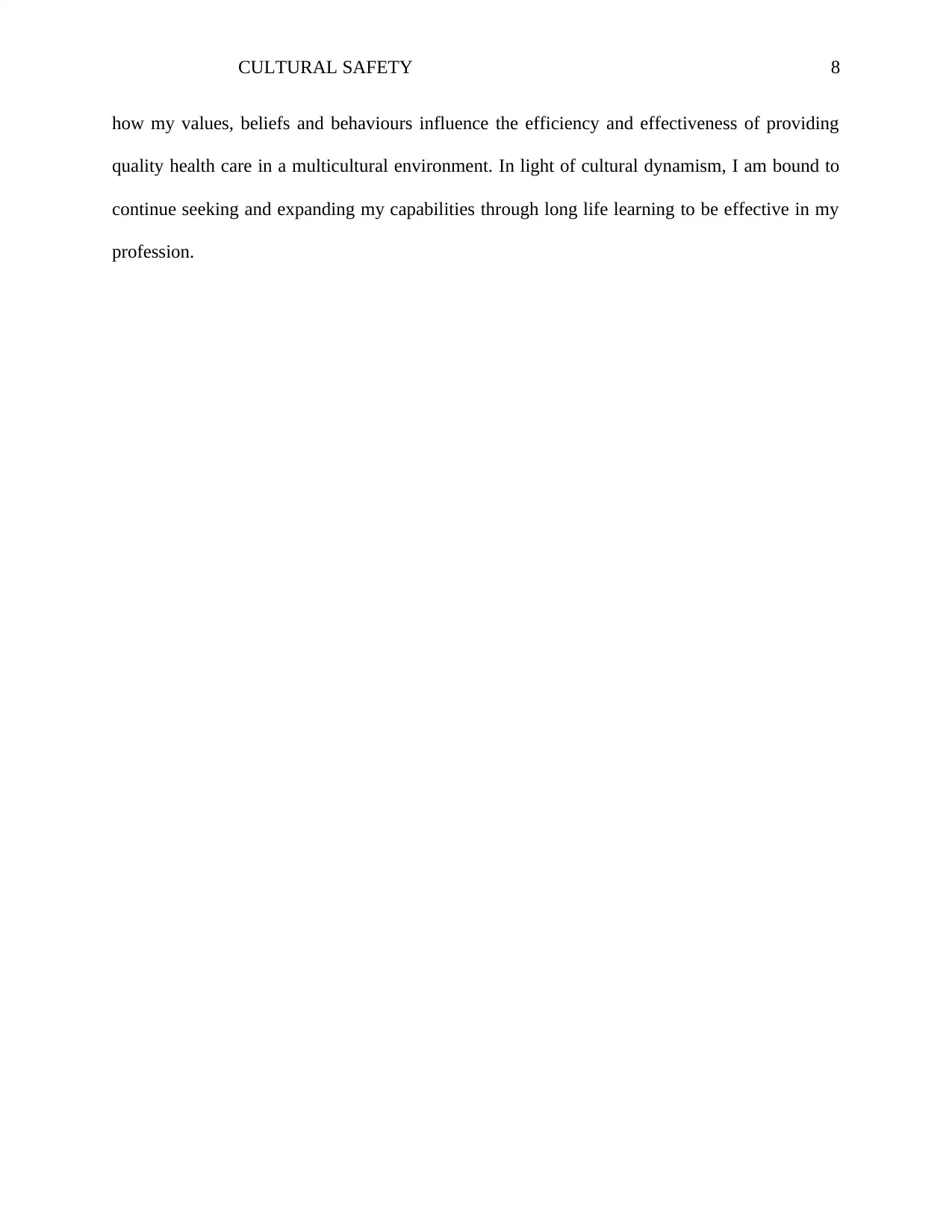
CULTURAL SAFETY 8
how my values, beliefs and behaviours influence the efficiency and effectiveness of providing
quality health care in a multicultural environment. In light of cultural dynamism, I am bound to
continue seeking and expanding my capabilities through long life learning to be effective in my
profession.
how my values, beliefs and behaviours influence the efficiency and effectiveness of providing
quality health care in a multicultural environment. In light of cultural dynamism, I am bound to
continue seeking and expanding my capabilities through long life learning to be effective in my
profession.
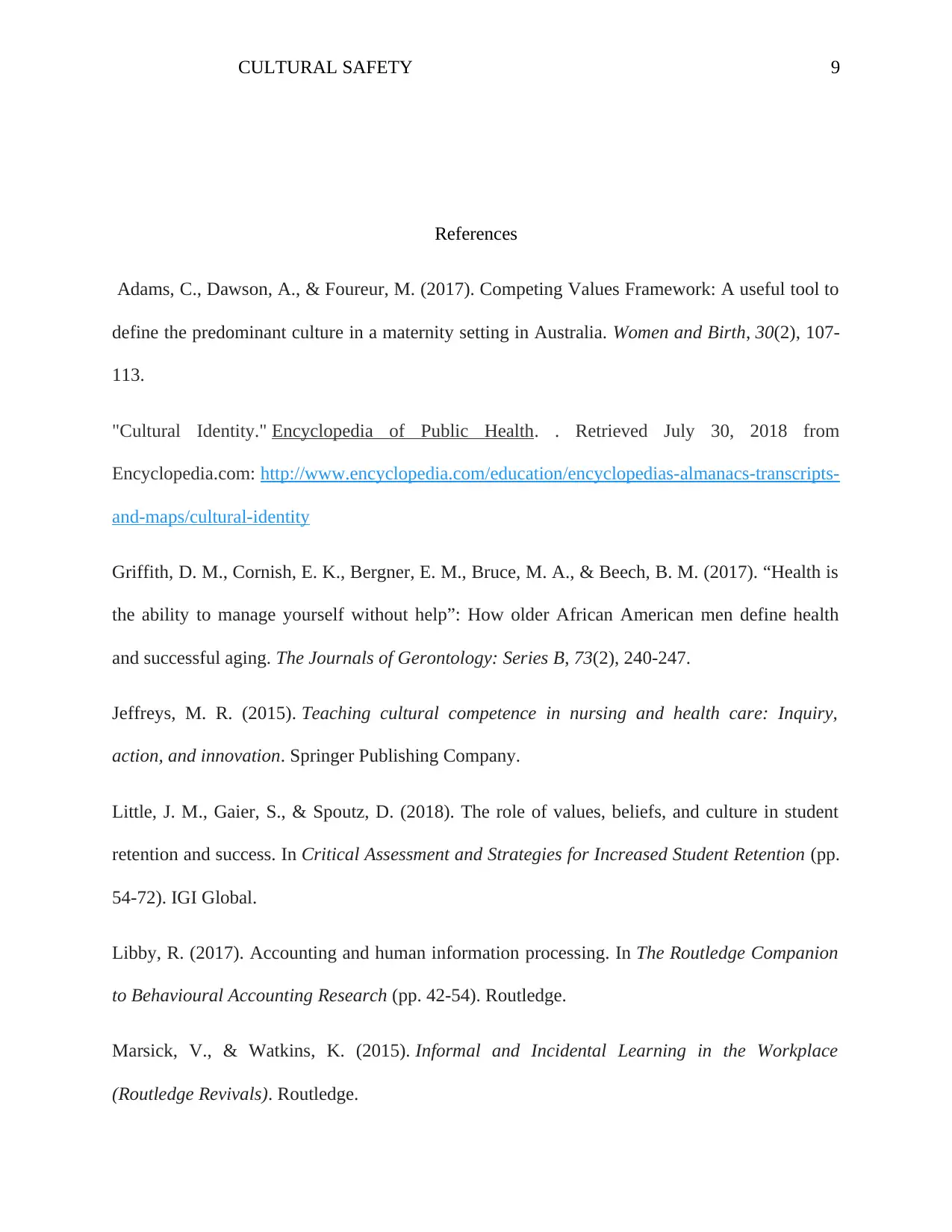
CULTURAL SAFETY 9
References
Adams, C., Dawson, A., & Foureur, M. (2017). Competing Values Framework: A useful tool to
define the predominant culture in a maternity setting in Australia. Women and Birth, 30(2), 107-
113.
"Cultural Identity." Encyclopedia of Public Health. . Retrieved July 30, 2018 from
Encyclopedia.com: http://www.encyclopedia.com/education/encyclopedias-almanacs-transcripts-
and-maps/cultural-identity
Griffith, D. M., Cornish, E. K., Bergner, E. M., Bruce, M. A., & Beech, B. M. (2017). “Health is
the ability to manage yourself without help”: How older African American men define health
and successful aging. The Journals of Gerontology: Series B, 73(2), 240-247.
Jeffreys, M. R. (2015). Teaching cultural competence in nursing and health care: Inquiry,
action, and innovation. Springer Publishing Company.
Little, J. M., Gaier, S., & Spoutz, D. (2018). The role of values, beliefs, and culture in student
retention and success. In Critical Assessment and Strategies for Increased Student Retention (pp.
54-72). IGI Global.
Libby, R. (2017). Accounting and human information processing. In The Routledge Companion
to Behavioural Accounting Research (pp. 42-54). Routledge.
Marsick, V., & Watkins, K. (2015). Informal and Incidental Learning in the Workplace
(Routledge Revivals). Routledge.
References
Adams, C., Dawson, A., & Foureur, M. (2017). Competing Values Framework: A useful tool to
define the predominant culture in a maternity setting in Australia. Women and Birth, 30(2), 107-
113.
"Cultural Identity." Encyclopedia of Public Health. . Retrieved July 30, 2018 from
Encyclopedia.com: http://www.encyclopedia.com/education/encyclopedias-almanacs-transcripts-
and-maps/cultural-identity
Griffith, D. M., Cornish, E. K., Bergner, E. M., Bruce, M. A., & Beech, B. M. (2017). “Health is
the ability to manage yourself without help”: How older African American men define health
and successful aging. The Journals of Gerontology: Series B, 73(2), 240-247.
Jeffreys, M. R. (2015). Teaching cultural competence in nursing and health care: Inquiry,
action, and innovation. Springer Publishing Company.
Little, J. M., Gaier, S., & Spoutz, D. (2018). The role of values, beliefs, and culture in student
retention and success. In Critical Assessment and Strategies for Increased Student Retention (pp.
54-72). IGI Global.
Libby, R. (2017). Accounting and human information processing. In The Routledge Companion
to Behavioural Accounting Research (pp. 42-54). Routledge.
Marsick, V., & Watkins, K. (2015). Informal and Incidental Learning in the Workplace
(Routledge Revivals). Routledge.
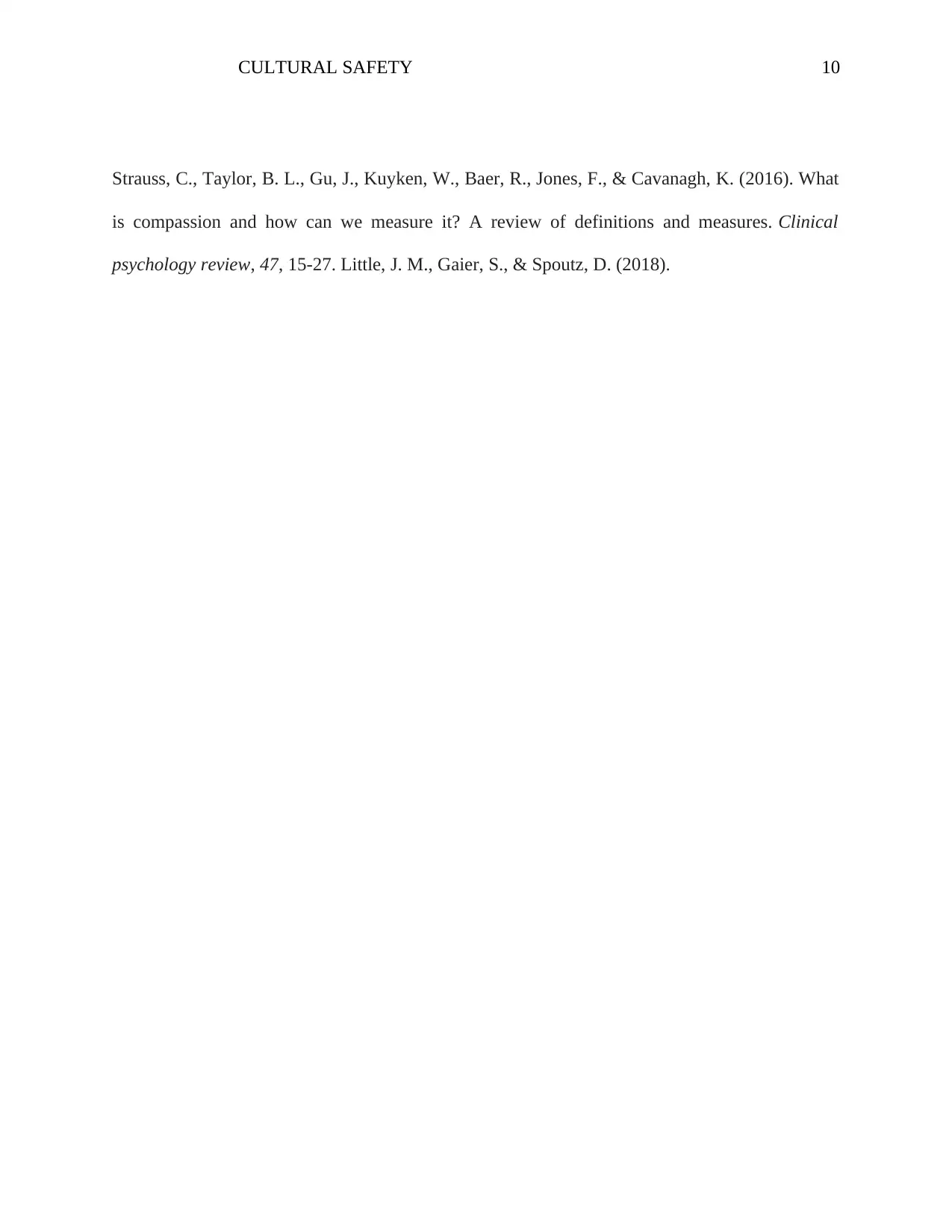
CULTURAL SAFETY 10
Strauss, C., Taylor, B. L., Gu, J., Kuyken, W., Baer, R., Jones, F., & Cavanagh, K. (2016). What
is compassion and how can we measure it? A review of definitions and measures. Clinical
psychology review, 47, 15-27. Little, J. M., Gaier, S., & Spoutz, D. (2018).
Strauss, C., Taylor, B. L., Gu, J., Kuyken, W., Baer, R., Jones, F., & Cavanagh, K. (2016). What
is compassion and how can we measure it? A review of definitions and measures. Clinical
psychology review, 47, 15-27. Little, J. M., Gaier, S., & Spoutz, D. (2018).
1 out of 10
Related Documents
Your All-in-One AI-Powered Toolkit for Academic Success.
+13062052269
info@desklib.com
Available 24*7 on WhatsApp / Email
![[object Object]](/_next/static/media/star-bottom.7253800d.svg)
Unlock your academic potential
© 2024 | Zucol Services PVT LTD | All rights reserved.



